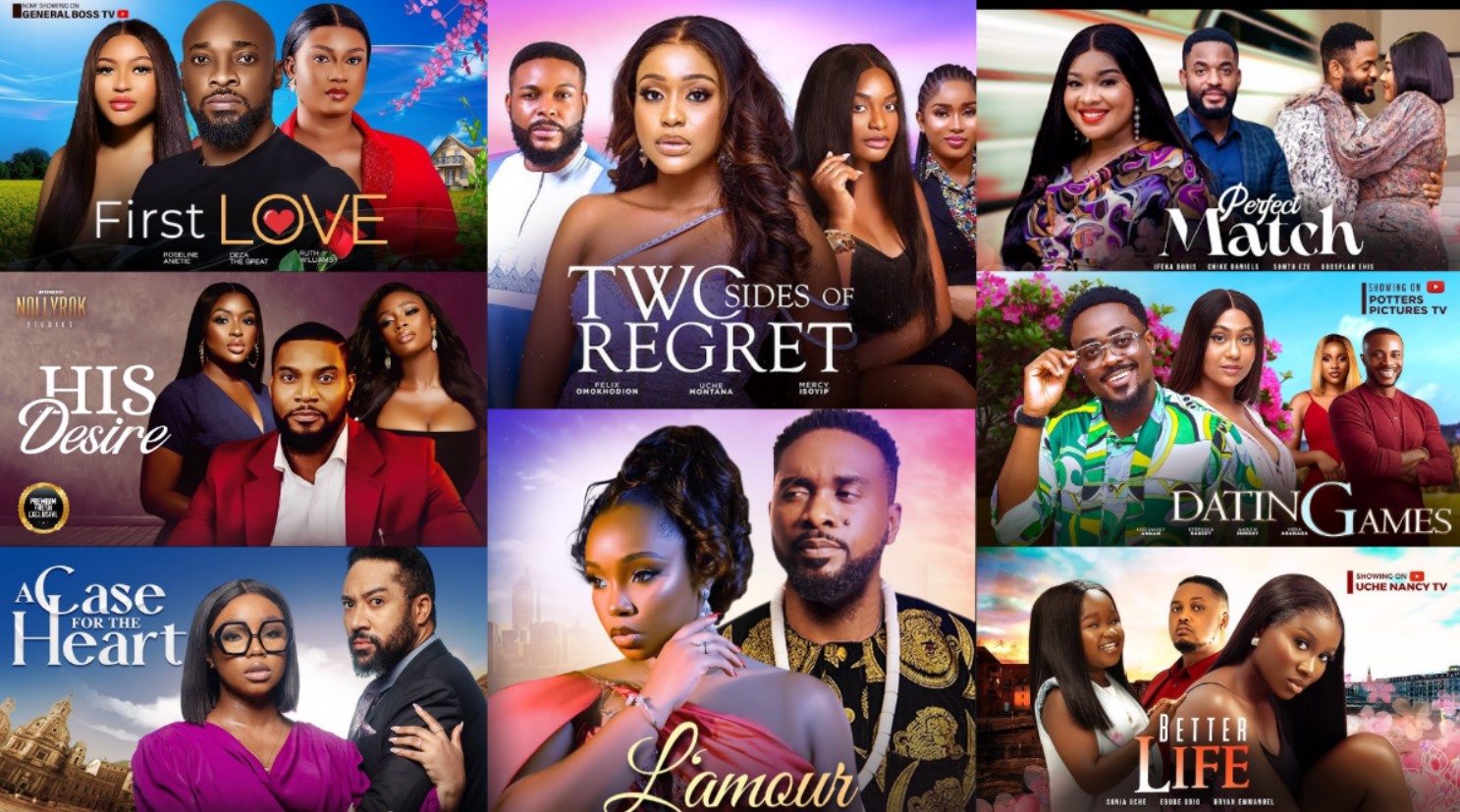Nollywood needs NollyTube, regardless of the merits and demerits, or the sustainability of YouTube as a distribution method.
By Vivian Nneka Nwajiaku
One day, I walked in on my mother watching a Nollywood film on YouTube. A notification had popped up on her phone, she had clicked on it, and she had found it difficult to stop watching. Such is the addictiveness of many of the new-age made-for-YouTube Nollywood films, or as we now call them: NollyTube.
Personally, I discovered NollyTube late. I followed a social media clip that caught my attention and pulled me to Bolaji Ogunmola’s YouTube channel. It was a romance drama titled Something More, starring Ogunmola and Blossom Chukwujekwu.
I had just come from a big-budget Nollywood romance film on a “proper” streaming service, and I was so frustrated by what I had watched that I needed a cleanse. Something More gave me that. I had thoughts, of course, but they truly did not matter that much to me because I had gotten my fix, and from a low-budget film for that matter. It was in that moment that I realised what I had been missing.
One of the oldest video streaming sites, YouTube has been around since 2005. That means it was literally in existence before the end of Nollywood’s home video era when films were mass produced and distributed via affordable physical video formats, from VHS to VCD and DVD. For context, 2005 was the same year that saw the release of late home video classics like Women’s Cot and Games Women Play.
However, YouTube cannot easily be called a film streaming service. It does not even market itself as such, even though its business model of democratising video distribution makes it amenable to all sorts of content, including films.
Besides, YouTube only launched in Nigeria (formally) in 2011, with Nollywood streaming pioneers immediately jumping at the opportunity to distribute Nollywood content digitally. iROKOtv is credited as the first company to engage in such distribution legally, before the platform migrated to its own streaming site shortly after.
In those early days, though, and for years to come, Nigerian web series thrived. Even I was not late to that party. NdaniTV’s Gidi Up (2013) and Skinny Girl in Transit (2015) were instant hits. Others followed: NdaniTV’s Rumour Has It (2016), REDTV and TNC Africa’s Our Best Friend’s Wedding (2017), REDTV’s The Men’s Club (2018), Neptune3 Studios’ Best Friends in the World (2018).
The decreasing interest in web series (despite outliers like All of Us (2024)) is a topic for another day. These days, feature length Nollywood films on YouTube are all the rage.
To be fair, NollyTube films have been in vogue for at least a few years. They might not have been as visible, with film streaming platforms like Netflix, Prime Video and Showmax practically owning the streaming market since 2016 (Showmax localised its services in 2019 while Prime did the same in 2022), but they were certainly catering to a considerably large audience.
Creators and filmmakers who either could not or did not want to go through institutional distributors opted for YouTube, aided by the platform’s user-generated model, where they have built a dedicated following.
As soon as those streaming giants stepped back, even mainstream filmmakers previously favoured by the film streamers started to see NollyTube’s appeal. For instance, Kunle Afolayan, who has had quite a number of Netflix deals, launched KAP STREAM in January of this year.
And who can blame them? Every now and then, a film does numbers that are quite literally incredible, triggering conversations about YouTube’s potential as a viable distribution platform for Nigerian productions, plus its merits, demerits, and sustainability.
Omoni Oboli’s March 2025 film, Love in Every Word, is just the latest example of this, having garnered almost twenty-two million streams in just one month of its release, another opportunity to have all these conversations. And for me, in particular, an opportunity to emphasise, from a viewers’ perspective, that Nollywood needs NollyTube, regardless of the merits and demerits, or the sustainability of YouTube as a distribution method.
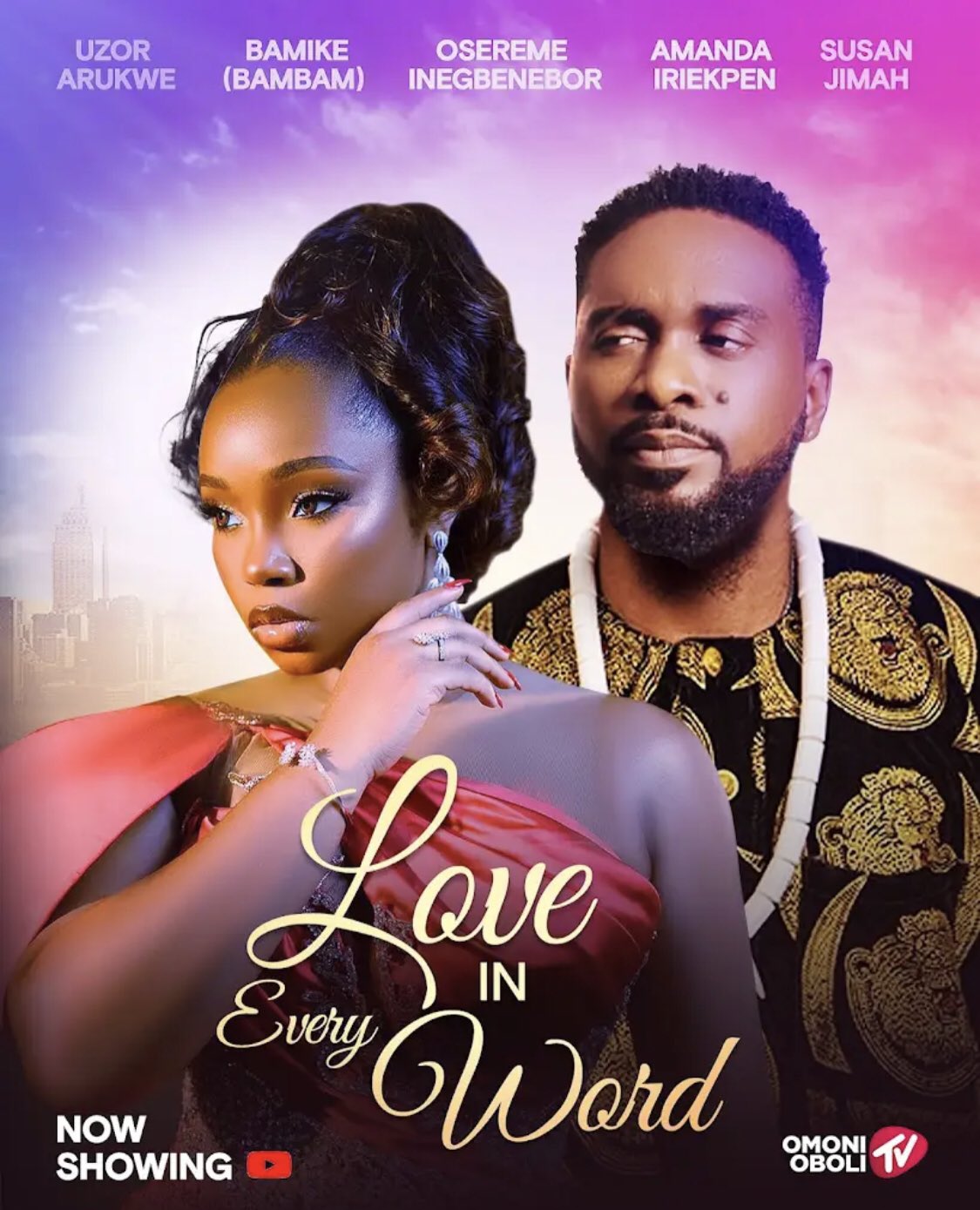
To be clear, I do consider the prevailing questions to be essential. This apparent culture of jumping from one trend to the next, while a very Nigerian behaviour, is not a particularly wise way to grow or stabilise an industry.
As a person who watches Nollywood and has one too many times struggled to find certain films after their theatrical or festival runs, I agree that Nollywood needs to figure out a stable and sustainable distribution model, and YouTube may not be the answer.
Yet, NollyTube is attractive for its accessibility. YouTube has a premium subscription plan, but viewers can still watch countless films for free, provided they have internet subscriptions and don’t mind the ads.
Consequently, it is a cheaper option than increasingly expensive cinemas as well as the regular film streaming platforms that require monthly membership subscriptions in addition to internet subscriptions.
In a 2024 survey with a small sample size of forty random audience participants, the participants who preferred YouTube to other paid streaming services cited free access, lower data consumption, and accessibility in general as major reasons. However, the participants who favoured YouTube were in the minority, mirroring a 2021 survey with a larger (but still small) sample size of 105 undergraduate students at a university business school in Lagos.
In the 2021 research, a majority also agreed that accessibility is a major benefit of YouTube–although the research did not compare YouTube to other streaming services–but it is instructive that only 2.9% of the 105 participants were frequent viewers of Nollywood films on YouTube despite 98.6% being were aware of the availability of Nollywood films on YouTube.
It may be true that the sample sizes are too small to reflect Nigeria’s large and diverse audience. It may also be true that 2021 was a long time ago, considering the evolution of distribution in Nollywood during the period.
The numbers may very likely have changed, affected by the investments and withdrawals of paid streaming sites, the participation of popular names like Omoni Oboli and Bimbo Ademoye, the increase in the popularity of NollyTube, and the economic conditions of the country, including the almost prohibitive costs of internet subscriptions.
But it is undeniable that NollyTube gets a bad rap. Many of us Nigerian filmgoers think ourselves better than NollyTube. We look down on the films the same way the Nigerian film industry was looked down on back when it was cool to say “I don’t watch Nollywood.” And there are reasons for that.
In the first place, people generally do not identify YouTube with films. When you think of film streaming as a Nigerian in Nigeria, you think Netflix, Prime Video, Showmax, usually in that order; you generally do not think YouTube, even though you know that Nollywood films are in abundance on the platform.
YouTube was created primarily as an online video sharing site, a social media platform of sorts. And despite the evolution of the platform over the years, that perception still holds sway such that people visiting YouTube tend to be visiting for social media purposes, from tutorial videos to vlogs, vodcasts and skits.
Then, there is the problem of quality. The prevailing argument is that Nollywood films on YouTube are of poor quality and that NollyTube is a platform for amateurs. Some have said that you have to turn your brain off to watch it. Some others simply cannot stand the recycled plots and casts.
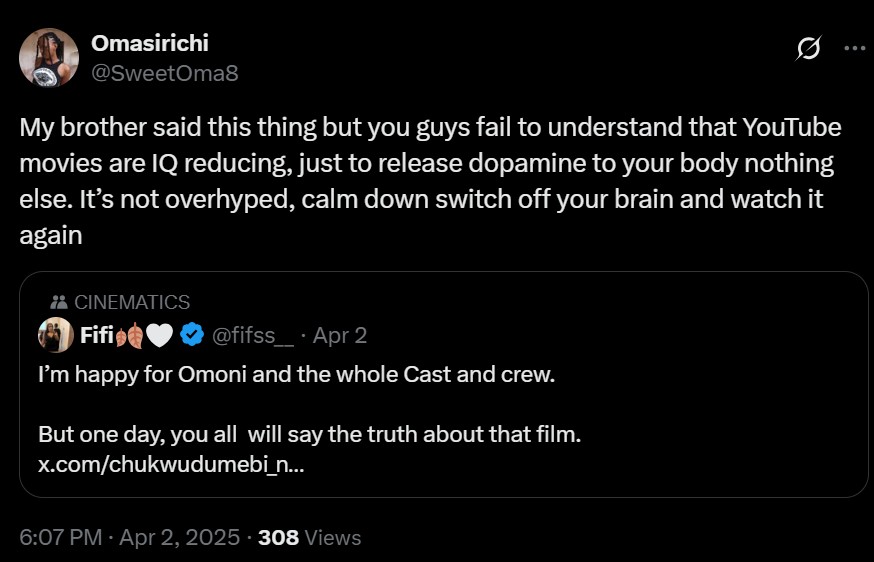
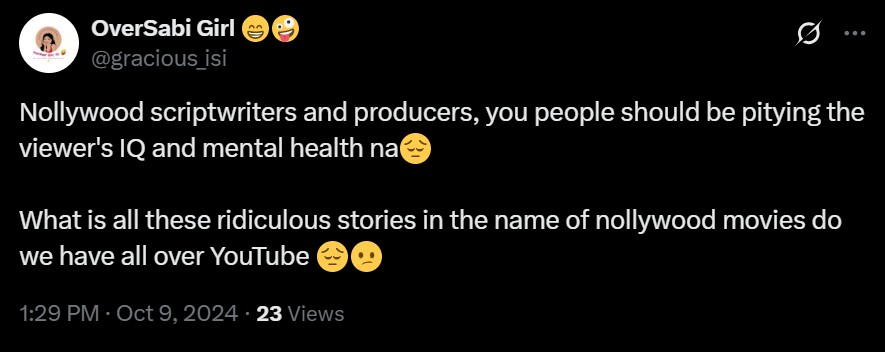
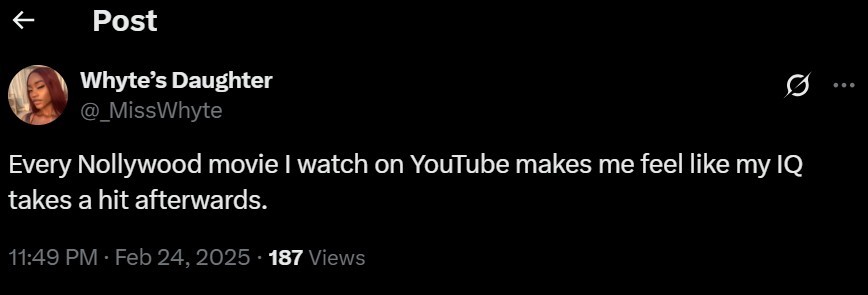

In one understandable rant I encountered on X (formerly Twitter), a user tweeted: “They have all lost it. The YouTube producers have taken Nollywood back to the ‘Asaba years’. Omoni [Oboli] for instance, releases movies almost every Friday, like how are you making movies weekly? They don’t have standards anymore, storyline is so poor, you feel drained watching some.”
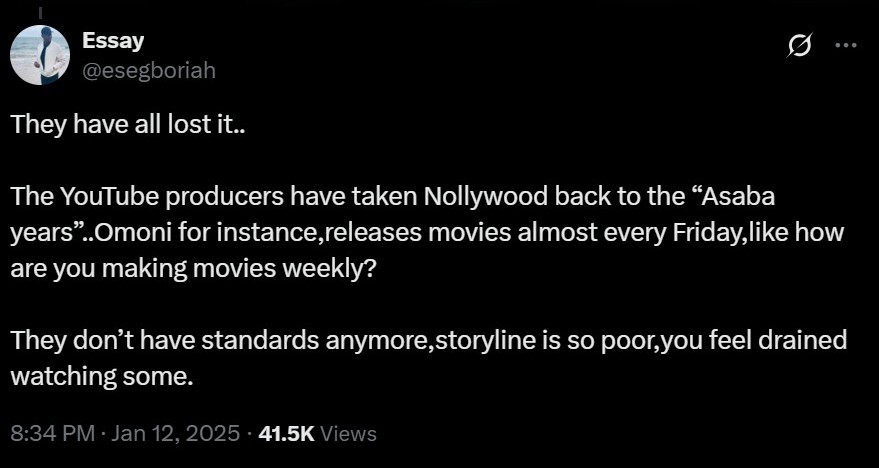
In a briefer exchange, a user tweeted: “YouTube movies are good for reducing your IQ.” In response, another user commented: “Brain rot section.”
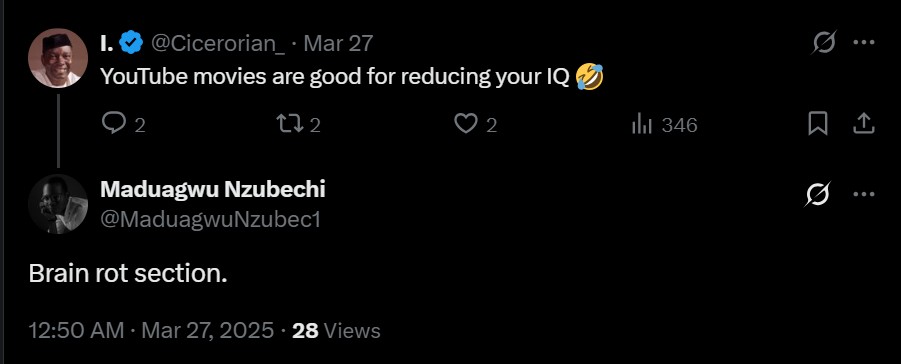
Respectfully, it is my humble, unsolicited opinion that what we have here is first a problem of branding and then a problem of quantity. If we were to be completely honest, NollyTube’s quality problem is not unique to the platform.
Sure, the idea that just anybody can make a film and put it up on a streaming platform without it being subject to the quality check that traditional distribution mediums guarantee does make YouTube an easy breeding bed for mediocrity, but do traditional distribution mediums truly guarantee quality?
Are the same arguments made against NollyTube films not being made against present-day mainstream Nollywood films that are distributed in cinemas and on “proper” film streaming platforms? Do we not regularly turn our brains off for many of those films? Do we not have recycled plots, casts, and crews? Really, how wide is the quality gap between NollyTube’s low-budget films and the Nollywood films that pass through traditional distribution? Or have we forgotten the Prime Dump era so soon?

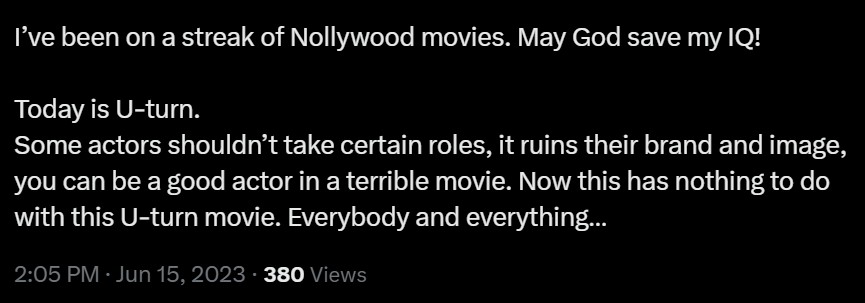




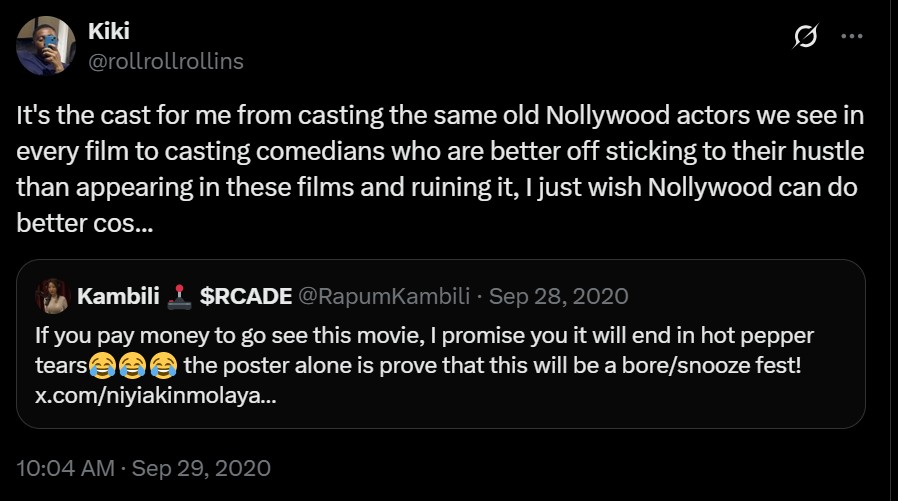
Mainstream Nollywood just brands itself differently, with better production and bigger budgets, the latter contributing to the former. But better does not always mean good. Plus, the insane quantity of Nollywood films on YouTube makes the storytelling and filmmaking flaws all the more glaring.
Nollywood screenwriter and filmmaker, Xavier Ighorodje, speaking to Premium Times, said something interesting: “The issue with YouTube is volume. If 30% of YouTube films are bad, that means 30 out of 100. If streaming platforms release 10 films, and three are bad, the percentage is still 30 percent. It’s just that YouTube releases more, so the flaws seem more apparent.” Thirty percent might be too low a figure for the point being made, but it does capture some of my thoughts on the issue.
In a 2021 essay, culture critic Jerry Chiemeke wrote about Nollywood’s parallel industry: “The guys in Asaba aired on Africa Magic Epic who almost always shoot in village-esque locations and produce eight instalments of a film with a running time of forty minutes each.” He called them Nollywood’s “B movies” and believed that they should be embraced, not scorned.
I want to echo this sentiment, especially in this era when Nollywood’s B movies are more than just the guys in Asaba. Many of the films on YouTube may be set in Lagos and other cities, but as that X user implied, NollyTube is the new Asaba Nollywood, at least in terms of the production model. Even Asaba filmmakers have relocated to YouTube, with multiple YouTube channels servicing their audience.
We may like it or we may not, but there is an audience for these films. Thousands of people watch and enjoy even the seemingly irredeemable ones, with comment sections flooded with interactions on their plots and acting performances.
One thing about NollyTube fans, they are passionate. It is evident in those comment section interactions on YouTube and other social media platforms like X, but I was still pleasantly surprised at the reactions I received when I chatted with a few NollyTube fans in the past week. For my interviewees, accessibility was a recurring factor, but there were other interesting reasons for their love.
Anjola, for example, a lawyer and NGO founder, is picky when it comes to NollyTube because she knows it is “tricky waters”, but she sticks with it for the actors she trusts, and she will watch anything with Uche Montana or Tana Adelana, both of whom she calls her “YouTube faves”.
She is also a fan of Uchenna Mbunabo because of a pattern she noticed. “I think he’s a really good leader who also wants his people to grow. He has a number of regular actors he features in his films who are now also producing their own stuff. And I see how he actively partners with a good number of them on their own projects. From the credits, anyways,” she tells me.
It’s the same for Marie, an entrepreneur, who loves and admires so many actresses. “It [is] nice that I can just search up their names and watch and rewatch movies with them at any time, even from past years.”
Ayo Tunz, a PR and Social Media Manager, loves the mix of old and new talents that NollyTube supplies. “We get to discover new talent, enjoy our OG talents, and enjoy simple, engaging, and entertaining movies every now and then. Right now, it’s the new hot thing, and producers are stepping up, storylines are getting more interesting, and we get to anticipate more shows.”
A new NollyTube enthusiast like me, Demilade was not a fan until recently, when she joined a NollyTube social media community. “Trust me, I don’t regret it,” she says. Demilade believes there is a clear difference between the old NollyTube movies and the present ones, and she’s particularly grateful for the new faces. “The new faces I’m seeing on YouTube are doing well; it’s just that a lot of them need to improve more on their acting skills. Then, let’s not forget script writers, quite a number of them are doing so well, they come up with perfect stories while some of them just rush the whole thing”.
For Olanna, a writer, the main attraction is the diversity in options. “Granted, it’s mainly romance, drama, and comedy on offer, but there are at least twenty NollyTube channels that offer different angles to these genres, and each of these channels has something for you, no matter your taste,” she notes.
She has recommendations: LizzyGold TV and Sonia Uche TV for slapstick comedy; Ruth Kadiri 247 and Uchenna Mbunabo TV for PG13 romance; Omoni Oboli TV and Uduak Isong TV for the more mature romance; and Showdeck for Young Adult stories.
But there’s a fascinating side attraction: the low expectations. “Because you don’t have much expectations, if the movie turns out to be not so good, you’re not as miffed. You know the production is low-budget,” Olanna explains, “and when you do find something that surpasses expectations, you’re even more excited”.
The most expansive conversation was with my namesake Nneka, a lawyer and human rights defender whose work takes her to a variety of places. “No matter how bad [the] network I have in whatever remote part of Nigeria I’m working in, my YouTube [will] load. I can’t say the same for Netflix”, she tells me.
But beyond that, she sticks with NollyTube for the authenticity. “I like the fact that with NollyTube, I could see authentic, to a certain extent, stories. It reminds me of Old Nollywood, Epic, and Rok movies with better picture quality in some places. It’s different from the cinemas or Netflix movies where everyone is rich and whatnot. You get to see real life stories, and for some producers that get it right, you can see where they’re coming from.
“So, it wasn’t just glitz and glamour. It was high school, young adult movies, and dilemmas. Something that cinemas and Netflix haven’t fully tapped into. Uduak Isong was the go-to for romance and comedy, and it was always real people with real stories as much as their budget allowed. I think there’s a certain authenticity their stories have that cinemas and Netflix don’t necessarily have. As someone who moved from Epic to Rok, NollyTube gives me what I want. Delulu but believable. Yes, they make mistakes, but they’ve gotten better at it”.
Even the Asaba Nollywood branch of NollyTube matters to Nneka. She believes that Asaba filmmakers discovered a platform to show their movies to the world, especially after being segregated by Africa Magic Epic and Rok Studios.
“There are mistakes you can’t see in a NollyTube movie, the old ones at least, and that’s because their crew were mainly Asaba movies crews that had worked on old Nollywood,” she observes. “Uchenna Mbunabo used to be a crew member on old movies. Uche Nancy was a costumer while her daughters used to act in old Nollywood.”
An additional point Nneka raises is that NollyTube generally does not discriminate. “I’ve seen actors transition from the high school teenage movies side of Triple J Plus (founders of Neptune3 Studios) to the side of proper adult movies, and they gave them appropriate roles.”
Most importantly, Nneka emphasises, there is an audience for NollyTube. “In the end, Nigerians, Lagos people also, have a lot of opinions because they think they are the target audience for NollyTube. Unfortunately, they aren’t. There are people in places that don’t have access and money for cinema and Netflix, but you see YouTube, they’re there. There are other African countries that love Nigerian movies so much. Check the comment sections and see. I mean, Francophone watchers pushed Ruth Kadiri and Omoni Oboli to open French pages”.
Of course, there is the need to be careful in navigating the diverse world that is NollyTube. If you lose focus, you might be drawn in by a poster wrongfully borrowed from a Showmax original for a film with the same title and starring the same lead actor, a Nollywood veteran for that matter, and find yourself watching the exact kind of film that once made it cool to say “God forbid that I watch Nollywood”.
After all, YouTube is a platform that allows just anybody to make just any video and upload it for public consumption.
But when you have that visceral reaction, remember that there is an audience for such films. Remember that people are entertained by them, and that they will always exist, whether the quality is good or bad.
Besides, if you truly give NollyTube a chance, you may find yourself surprised at how much some of the films can make you feel feelings that you may not have experienced from Nollywood’s A movies for quite some time.
The existence of B movies is not a bigger problem in Nollywood than it is in any other industry. Nollywood still needs its low-budget movies. And the best audiences can hope for is a time when truly good Nollywood films are not scarce and Nollywood filmmaking is predominantly decent, at least, regardless of the medium of distribution.
Vivian Nneka Nwajiaku is a writer, film critic, TV lover, and occasional storyteller writing from Lagos. She has a master’s degree in law but spends most of her time reading about and discussing films and TV shows. She’s particularly concerned about what art has to say about society’s relationship with women. Connect with her on Twitter @Nneka_Viv


